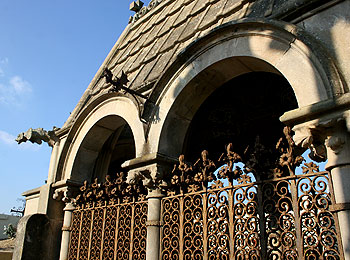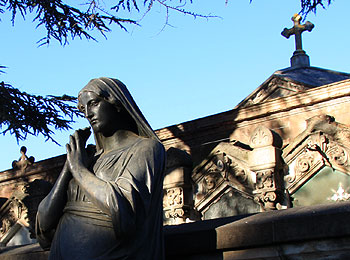| |
|
El cementiri modernista fou una obra que es projectà a finals del s.XIX i que es va anar configurant durant els primers anys dins el s.XX.
És, sens dubte, un conjunt d'indubtable interès, que obre una ampla perspectiva del que va ser l'art funerari durant aquella època. La inauguració oficial d'aquest recinte va tenir lloc el 2 de novembre de 1901 i, a partir de llavors, hi varen participar arquitectes i escultors de renom: Josep Puig i Cadafalch, Antoni M. Gallissà i Soqué, Lluís Llimona, Vicenç Artigas i Albertí, Bonaventura Conill i Montobbio, Ismael Smith, Eusebi Arnau, entre d'altres, així com deixebles de l'escola de Gaudí.
|
|
El cementerio modernista fue una obra que se proyectó a finales del s.XIX y que se fue configurando durante los primeros años del s.XX.
Es, sin duda, un conjunto de indudable interés, que abre una amplia perspectiva de lo que fue el arte funerario durante aquella época.
La inauguración oficial de este recinto tuvo lugar el 2 de noviembre de 1901 y, a partir de entonces, participaron arquitectos y escultores de fama: Josep Puig i Cadafalch, Antoni M. Gallissà Soqué, Vicenç Artigas Albertí, Bonaventura Conill Montobbio, Ismael Smith, Eusebi Arnau entre otros i discipulos de la escuela Gaudí.
|
|
The modernist cemetery of Lloret de Mar was a building work projected at the end of the 19th century, and finished along the 20th century.
It’s a space with great interest architectonic and show how important was the funerary art during this epoch. The official inauguration of the cemetery took place in 2nd of November 1901. From that moment on several famous architects and sculptors worked about graves as: Josep Puig Cadafalch, Antoni M. Gallissà Soqué, Lluís Llimona, Vicenç Artigas Albertí, Bonaventura Conill Montobbio, Ismael Smith, Eusebi Arnau, among others. As well disciples of Antoni Gaudi’s school worked there.
|
|











